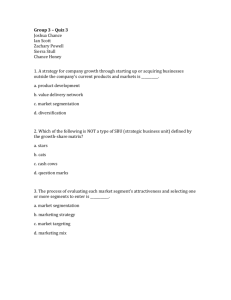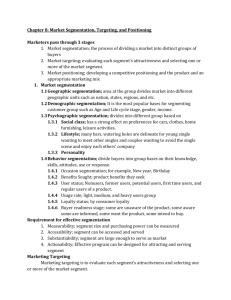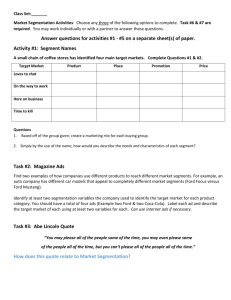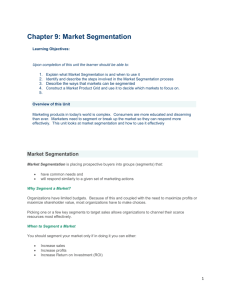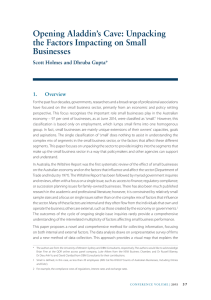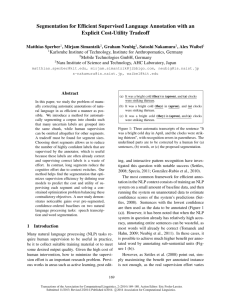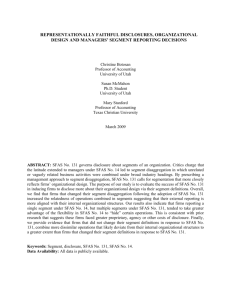Marketing Segmentation
advertisement
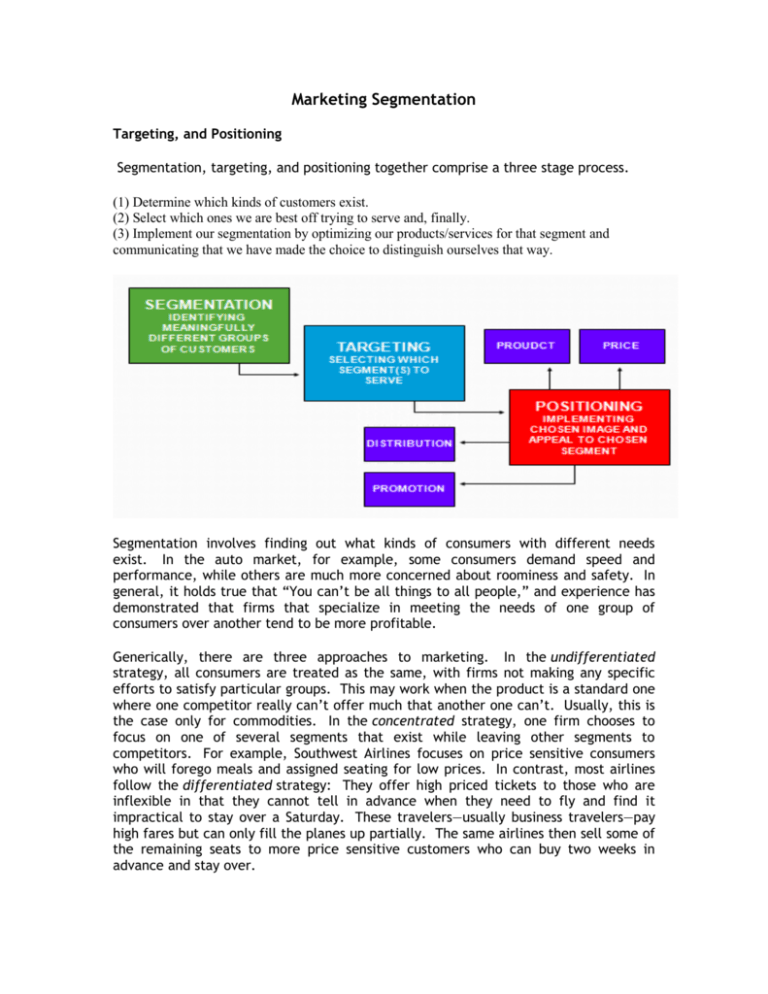
Marketing Segmentation Targeting, and Positioning Segmentation, targeting, and positioning together comprise a three stage process. (1) Determine which kinds of customers exist. (2) Select which ones we are best off trying to serve and, finally. (3) Implement our segmentation by optimizing our products/services for that segment and communicating that we have made the choice to distinguish ourselves that way. Segmentation involves finding out what kinds of consumers with different needs exist. In the auto market, for example, some consumers demand speed and performance, while others are much more concerned about roominess and safety. In general, it holds true that “You can’t be all things to all people,” and experience has demonstrated that firms that specialize in meeting the needs of one group of consumers over another tend to be more profitable. Generically, there are three approaches to marketing. In the undifferentiated strategy, all consumers are treated as the same, with firms not making any specific efforts to satisfy particular groups. This may work when the product is a standard one where one competitor really can’t offer much that another one can’t. Usually, this is the case only for commodities. In the concentrated strategy, one firm chooses to focus on one of several segments that exist while leaving other segments to competitors. For example, Southwest Airlines focuses on price sensitive consumers who will forego meals and assigned seating for low prices. In contrast, most airlines follow the differentiated strategy: They offer high priced tickets to those who are inflexible in that they cannot tell in advance when they need to fly and find it impractical to stay over a Saturday. These travelers—usually business travelers—pay high fares but can only fill the planes up partially. The same airlines then sell some of the remaining seats to more price sensitive customers who can buy two weeks in advance and stay over. Note that segmentation calls for some tough choices. There may be a large number of variables that can be used to differentiate consumers of a given product category; yet, in practice, it becomes impossibly cumbersome to work with more than a few at a time. Thus, we need to determine which variables will be most useful in distinguishing different groups of consumers. We might thus decide, for example, that the variables that are most relevant in separating different kinds of soft drink consumers are (1) preference for taste vs. low calories, (2) preference for Cola vs. non-cola taste, (3) price sensitivity—willingness to pay for brand names; and (4) heavy vs. light consumers. We now put these variables together to arrive at various combinations. Several different kinds of variables can be used for segmentation. Demographic variables essentially refer to personal statistics such as income, gender, education, location (rural vs. urban, East vs. West), ethnicity, and family size. Campbell’s soup, for instance, has found that Western U.S. consumers on the average prefer spicier soups—thus, you get a different product in the same cans at the East and West coasts. Facing flat sales of guns in the traditional male dominated market, a manufacturer came out with the Lady Remmington, a more compact, handier gun more attractive to women. Taking this a step farther, it is also possible to segment on lifestyle and values.” Some consumers want to be seen as similar to others, while a different segment wants to stand apart from the crowd. Another basis for segmentation is behavior. Some consumers are “brand loyal”—i.e., they tend to stick with their preferred brands even when a competing one is on sale. Some consumers are “heavy” users while others are “light” users. For example, research conducted by the wine industry shows that some 80% of the product is consumed by 20% of the consumers— presumably a rather intoxicated group. One can also segment on benefits sought, essentially bypassing demographic explanatory variables. Some consumers, for example, like scented soap (a segment likely to be attracted to brands such as Irish Spring), while others prefer the “clean” feeling of unscented soap (the “Ivory” segment). Some consumers use toothpaste primarily to promote oral health, while another segment is more interested in breath freshening. In the next step, we decide to target one or more segments. Our choice should generally depend on several factors. First, how well are existing segments served by other manufacturers? It will be more difficult to appeal to a segment that is already well served than to one whose needs are not currently being served well. Secondly, how large is the segment, and how can we expect it to grow? (Note that a downside to a large, rapidly growing segment is that it tends to attract competition). Thirdly, do we have strengths as a company that will help us appeal particularly to one group of consumers? Firms may already have an established reputation. While McDonald’s has a great reputation for fast, consistent quality, family friendly food, it would be difficult to convince consumers that McDonald’s now offers gourmet food. Thus, McD’s would probably be better off targeting families in search of consistent quality food in nice, clean restaurants. Positioning involves implementing our targeting. For example, Apple Computer has chosen to position itself as a maker of user-friendly computers. Thus, Apple has done a lot through its advertising to promote itself, through its unintimidating icons, as a computer for “non-geeks.” The Visual C software programming language, in contrast, is aimed a “techies.” Operationally excellent firms, which maintain a strong competitive advantage by maintaining exceptional efficiency, thus enabling the firm to provide reliable service to the customer at a significantly lower cost than those of less well organized and well run competitors. The emphasis here is mostly on low cost, subject to reliable performance, and less value is put on customizing the offering for the specific customer. Wal-Mart is an example of this discipline. Elaborate logistical designs allow goods to be moved at the lowest cost, with extensive systems predicting when specific quantities of supplies will be needed. Customer intimate firms, which excel in serving the specific needs of the individual customer well. There is less emphasis on efficiency, which is sacrificed for providing more precisely what is wanted by the customer. Reliability is also stressed. Nordstrom’s and IBM are examples of this discipline. Technologically excellent firms, which produce the most advanced products currently available with the latest technology, constantly maintaining leadership in innovation. These firms, because they work with costly technology that need constant refinement, cannot be as efficient as the operationally excellent firms and often cannot adapt their products as well to the needs of the individual customer. Intel is an example of this discipline.




